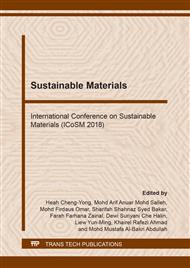p.374
p.385
p.393
p.399
p.410
p.415
p.422
p.433
p.440
Mechanical Properties of Biocomposite Films Based on Poly(Lactic Acid) Reinforced with Cellulose Fibers
Abstract:
In this paper, we intended to study and improve the mechanical properties of poly (lactic acid) (PLA) composites with cellulose fibers from recycled newspapers. The influence of cellulose fiber content on tensile mechanical properties and swelling behavior of biocomposite films were investigated. In addition, the morphological property of biocomposite films was determined by scanning electron microscopy (SEM). It was found that the cellulose fibers have directly affected to the swelling behavior of biocomposite films. In addition, it was found that the cellulose fibers were found embedded between PLA matrices, which resulting to the improvement and increase the mechanical properties of biocomposite films. These findings illustrate that the cellulose fibers from recycled newspaper possesses good fillers and could be a good alternative reinforcement for biopolymer composites.
Info:
Periodical:
Pages:
410-414
Citation:
Online since:
August 2018
Price:
Сopyright:
© 2018 Trans Tech Publications Ltd. All Rights Reserved
Share:
Citation:


